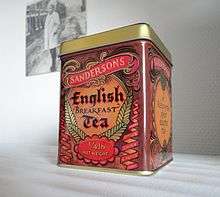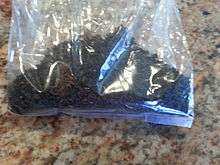English breakfast tea

English breakfast tea is a traditional blend of teas originating from Assam, Ceylon, and Kenya.[1] It is one of the most popular blended teas, common in British tea culture.
English breakfast tea is a black tea blend usually described as full-bodied, robust, rich and blended to go well with milk and sugar, in a style traditionally associated with a hearty English breakfast.
The black teas included in the blend vary, with Assam, Ceylon and Kenyan teas predominating, and Keemun sometimes included in more expensive blends. Common brands of English breakfast tea include Twinings, Dilmah, Taylors of Harrogate, Ahmad Tea, Qualitea and Darvilles of Windsor. Other popular black tea brands, such as Yorkshire Tea, PG Tips and various supermarket own-brand tea blends, are similar to English breakfast tea, despite not being marketed as such.
Origins

Accounts of its origins vary. Drinking a blend of black teas for breakfast is indeed a longstanding British custom. The practice of referring to such a blend as "English breakfast tea" appears to have originated not in England but America, as far back as Colonial times.[2] An additional account (referencing a period-era Journal of Commerce article) dates the blend to 1843 and a tea merchant named Richard Davies in New York City. Davies, an English immigrant, started with a base of Congou and added a bit of Pekoe and Pouchong. It sold for 50 cents a pound, and its success led to imitators, helping to popularize the name.[3] An investigation to find this source failed to locate it but did come upon an earlier reference to the same story in an 1876 edition of the Daily Alta California, citing "a New York commercial journal" and dating the tea's origin to 1844.[4][5] In an 1884 American publication it was noted that "Bohea teas (are) known to trade in this country as "English Breakfast" tea, from its forming the staple shipment to England".[6][4] Another account gives its origins in Scotland in 1892, where it was initially known simply as "breakfast tea", and was in part popularised by Queen Victoria.[7][8][9][10]
See also
References
- ↑ Jane Pettigrew and Bruce Richardson. "The Tea Lover's Companion: A Guide to Teas Throughout the World". London, U.K.: The National Trust. p. 54.
- ↑ ZoeAnn Holmes. "English breakfast tea - Food Resource - Oregon State University". food.oregonstate.edu. Archived from the original on 2013-11-04. Retrieved 2013-03-26.
- ↑ "History of the English Breakfast Tea". Logoi.com. Archived from the original on 2009-01-10. Retrieved 2009-03-12.
- 1 2 "English Breakfast Tea - Evolving Blend or Invented in NYC?". 12 March 2015.
- ↑ "Daily Alta California 5 February 1876 — California Digital Newspaper Collection".
- ↑ ""A cup of tea", containing a history of the tea plant from its discovery to the present time, including its botanical characteristics ... and embracing Mr. William Saunders' pamphlet on "Tea-culture - a probable American industry"".
- ↑ "English Breakfast". Marahtea.com. Retrieved 2016-03-15.
- ↑ "A history of breakfast". Yorkshire Tea. 2013-02-14. Retrieved 2016-03-15.
- ↑ "What is English Breakfast Tea? What does it have to do with breakfast?". MrBreakfast.com. Retrieved 2016-03-15.
- ↑ "A brief history of Brodie, Melrose, Drysdale & Co Ltd". Brodies1867.co.uk. Retrieved 2016-03-15.